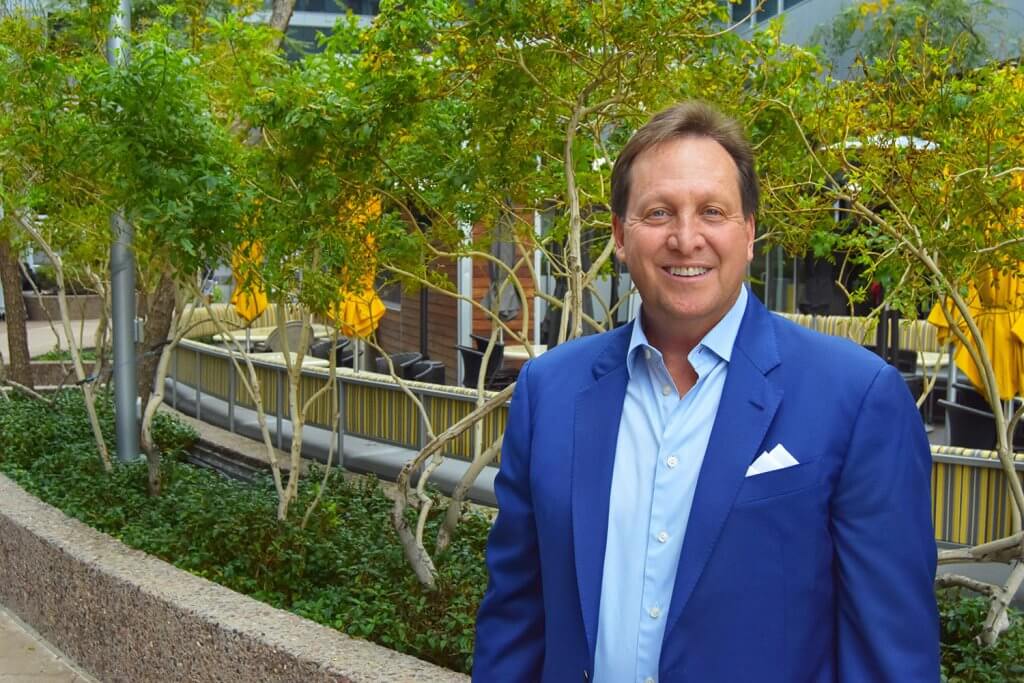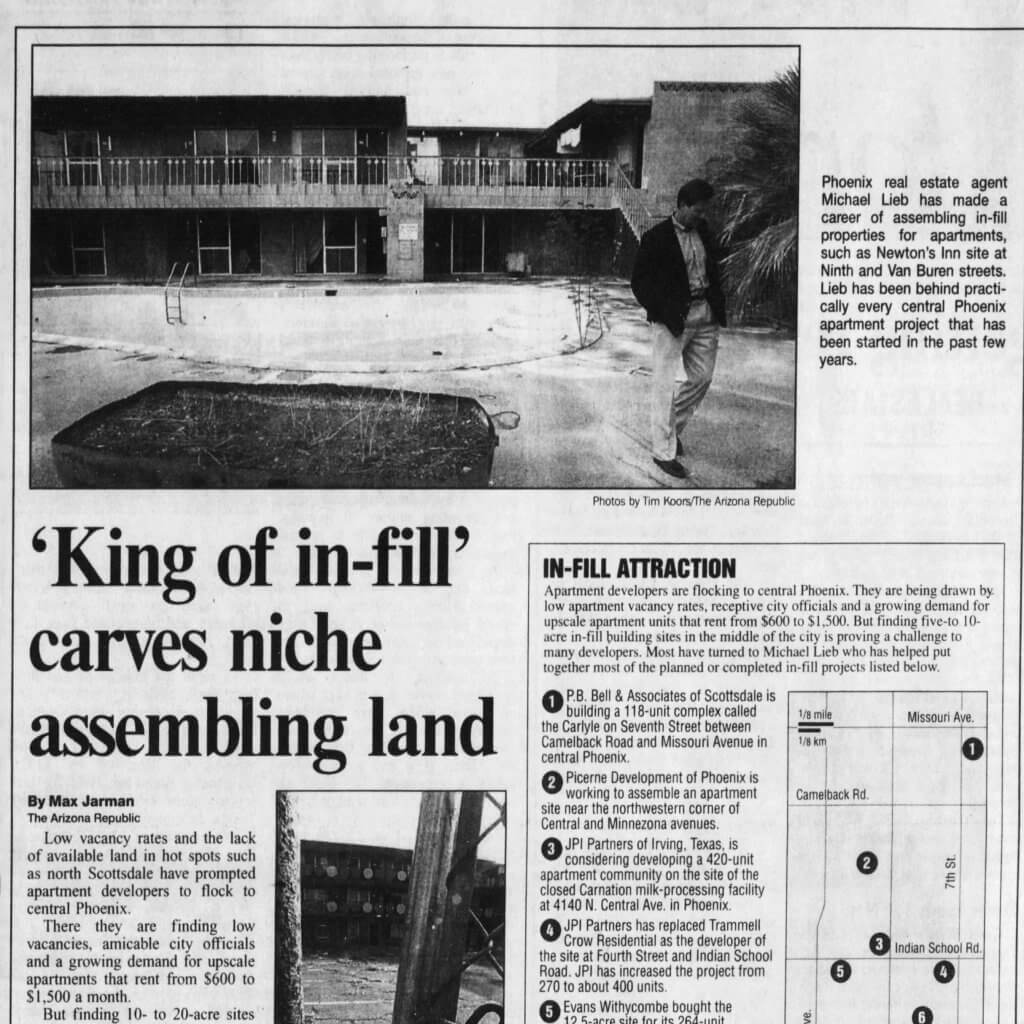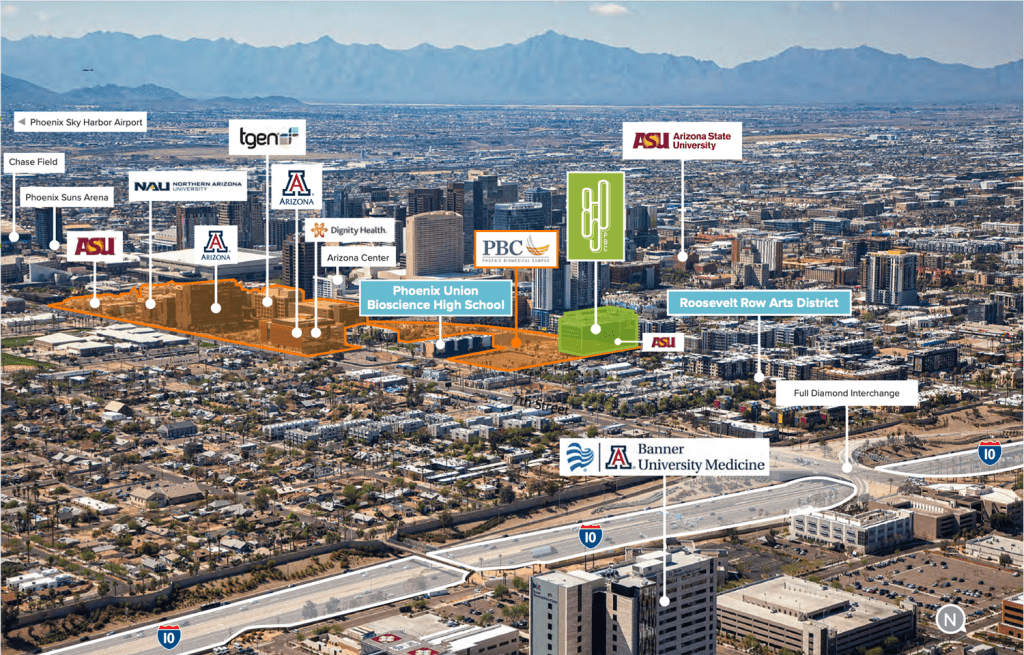Michael Lieb is an essential part of the story in the formation of the Phoenix Bioscience Core.
In the early 2000s, Downtown Phoenix arrived at a pivotal juncture: What would it take for Downtown Phoenix to become an economic engine?
Enter Lieb into the orbit of Phoenix Community Alliance. Dubbed the “King of Infill” by Former PCA President Don Keuth, he was responsible for countless assemblages of land, both under the direction of PCA and on his own, around Downtown and Metro Phoenix.
The “City-Shapers” series fills in the gaps in historical knowledge of Phoenix Community Alliance. This four-decade-old business advocacy organization has influenced the growth of Downtown and beyond.

Former PCA Central City Planning and Development Committee Co-Chair Michael Lieb pictured outside the Downtown Phoenix, Inc./Phoenix Community Alliance offices. (Photo by Taylor Costello)
Q: What motivated you to join Phoenix Community Alliance?
Lieb: It would have been when Paul [Johnson] was on the Phoenix City Council before he got elected Mayor [of Phoenix] in 1990 when I was about 30. I was his fundraising chair all those years he was on council, then mayor, and when he ran for governor [in 1994].
One of my dearest friends and mentor was [Former Councilman] Barry Starr. Once Barry became the president of PCA, he recruited me as an Executive Committee Member.
I remember Barry telling me, “It’s good for your business but better for your soul.”
And I was taught that lesson by [business partner] Wayne [Howard] and folks like Ron Bookbinder, in the real estate business, the planning commission, or committees. So, I saw the leadership on the Executive Committee [as putting that into practice].
Q: What other economic initiatives did PCA advocate for during your time as a Member?
Lieb: One of the prominent committees was Mo [Stein], and a couple of others hired a planning consultant, called Jerde Partners, out of Los Angeles, to do the plan of all of Downtown.
Around 2002, PCA, led by Chair Jerry Colangelo, fundraised $750,000 to conceptualize a plan for sustainable growth in Downtown around staples like housing, education and transit-oriented development. Over time, the plan initialized dialogue for stakeholders, and neighborhood groups, like Downtown Voices Coalition, to form. Countless hours of public comment and community discussions further refine the plan.
Eventually, the Downtown Strategic Vision, adopted by Phoenix City Council in 2004, was used as a model for then-Phoenix Mayor Phil Gordon and ASU President Dr. Michael Crow to build the Downtown Phoenix campus, bringing ASU to the core. As a result, in Fall of 2022, the Downtown campus enrolled more than 15,000 students around a robust economic community.
Q: How did you become the co-chair of PCA’s oldest Committee, the Central City Planning and Development Committee, with current co-Chair Billy Shields?
Lieb: I am a housing person, so my focus was getting developers to consider Downtown as an option. I assembled the old hotels just east of the Children’s Museum of Phoenix for the first large residential project in the area. For 11 years, I was on the [City of Phoenix’s] Board of Adjustment.
Don [Keuth] asked me to chair the Committee to sell the attributes of Downtown to the outside investment world. For years, we worked hard to create buzz for our larger membership, with monthly programming and speakers to attend to get 150 people to show up. Finally, it became a regular thing. It took off when council people wanted to come in.
We filled up meetings with residential developers looking at different local sites. And it was great because most were national or regional guys doing similar projects in Austin and other places.
I’m proud this Committee prospered and to see my friend Billy Shields continue our original mission forward in a successful path.

A November 1997 Arizona Republic article utilizing Don Keuth’s “King of In-Fill” title bestowed upon Lieb. (Courtesy of the Arizona Republic Archives)
Q: The site that is now the Phoenix Bioscience Core was once briefly considered by the Arizona Cardinals as a new stadium in the early 2000s. How did the land assemblage, a collaboration between the then Downtown Phoenix Partnership and Phoenix Community Alliance, happen?
Lieb: The bioscience core exists today because our organizations worked together in Phoenix’s best interests.
The Cardinals decided they would move from Sun Devil Stadium in Tempe. For a site to be considered, you had to meet specific criteria. One of them was 50 or 70 acres for a roll-out field. We identified the area and had to show control of it, control being under contract or owned. You had to show them you had the $25 or $30 million to get the site ready for streets, infrastructure, and utilities.
I made a career out of doing land assemblages, 30 parcels here, 15 parcels here. The land value at the time was $10 to $13 per square foot. I might pay $30 to $40 per square foot, but those numbers are not unreasonable for Downtown land for its usage.
[To assemble the land identified], I started going after low-hanging fruit, like owners with three or four parcels. I had 5 to 10 meetings daily, morning, day, and night because I had about 120 days to assemble approximately 50 to 60 separate parcels of land, buildings, and hotels.
Q: What was the process of having people sign these contracts, did property owners know you were coming?
Lieb: It was all over the news, so there was no element of surprise. I would do my research and knock on the door, and they’d go, “We were wondering when you were going to come!”
I was very upfront with people, “If you sign, you’re giving me 120 days of feasibility if the site is selected. And if it does, you’re getting three times the value. If it doesn’t, you’ve got ownership of your land.” I also had the CDC [Downtown Phoenix Community Development Corporation, an affiliate of Downtown Phoenix Inc. and Phoenix Community Alliance] include an option that said the owner could move forward if the site was not selected.

An illustrated photo of the Phoenix Bioscience Core, with all major partners and university labeled, as they current exist today. The core extends all the way to the north on Roosevelt Row, with Wexford Science + Technology’s 850 PBC, and to the ASU Mercado buildings past Van Buren Street to the south. (Photo courtesy of Wexford Science + Technology)
Q: How did all parties move beyond a potential stadium Downtown and focus on developing a biomedical core?
Lieb: It was beneficial as I was doing this, [Councilman] Michael Johnson was elected, and this was his first major decision. He was smart enough to get behind it. It showed some courage because he had no political chips in the jar yet.
Mayor [Skip] Rimsza, City Council, with PCA leadership, identified excess monies in the Sports Facilities Fund earmarked for re-development in the area. As a result, we were able to use approximately $20 million of this money to buy the land.
Through the support of PCA leaders like Jerry Colangelo, Marty Shultz, and others, they convinced city leadership that we would never get another chance to control our destiny with this large block of land. I did the assemblage, but they were the vision and political muscle behind it.
With over 25 years of services and a transitioning Downtown, Lieb stepped away from the organization, having poured everything into bringing residential activity back to the area.
When he handed off Central City Planning and Development to current Co-Chair Matt Seaman in August 2018, they continued where he left off: emphasizing economic development advocacy through diverse housing options in Greater Downtown.




